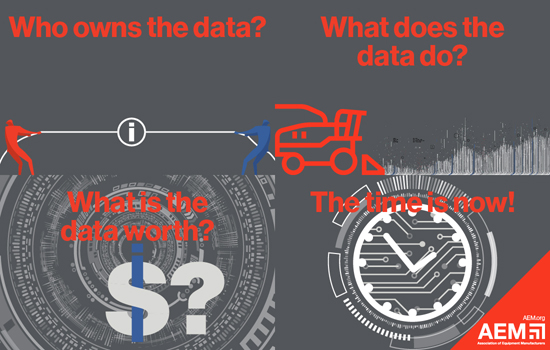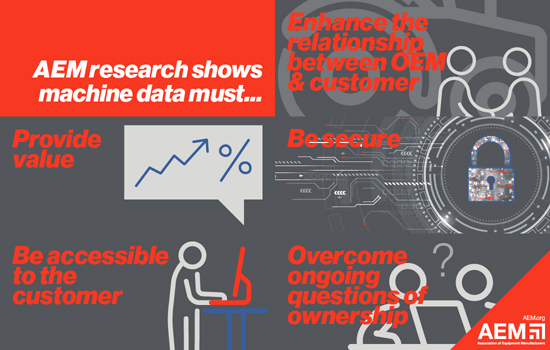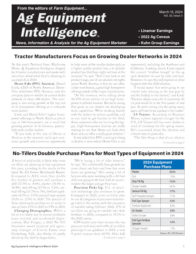According to a recent report from the Assn. of Equipment Manufacturers (AEM), it seems to be the consensus among ag equipment manufacturers and the markets they serve that the future of farming will be driven by data.
And as more of that data continues to be produced in what has become an increasingly interconnected world, both OEMs and their customers are being forced to answer a difficult question, one that will shape the future of agriculture for years to come:
Just who owns the data, and how should it be used?
Tackling the Question Of Data Ownership and Access
There’s simply no overstating the influence of data – and the question of data ownership and access – on the OEM-customer relationship in ag. According to a recent AEM research report conducted by Clutch, the need for ag equipment end users to have access to information from manufacturers has grown exponentially.
This need has placed dramatic pressure on OEMs, the Clutch research found. In the past, manufacturers may have been afforded a couple of weeks to do the following before providing equipment end users with access to the data coming off their machines:
- Clean the data
- Analyze and understand it
- Make sure they’re not giving away trade secrets
- Review and test the data to make sure it was accurate

Now, however, customers demand immediate access to machine data. And it’s really not hard to understand why. A significant percentage of the decisions farmers are required to make today are based on the information obtained directly from their equipment, from what to plant and where they plant it to what application they apply onto it and how much of said application gets applied. Quite simply said, machine data and the insights gained from it are among the most useful tools in helping ag equipment end users be more efficient and effective at doing their jobs.
Farming is an incredibly unique – and challenging – line of work. Farmers are price-takers and, because the nature of their work doesn’t allow for dictating prices, they have little control over many of the notable financial aspects associated with what they do for a living. And while farmers can dictate timing, setting market prices are beyond their control.
It’s a reality that impacts – for better or worse – how farmers approach:
- Machine data itself
- Ownership and access of the data
- Relationships with the OEMs tasked with designing and manufacturing the offerings farmers invest in and employ
Data's Influence on the Future of Farming
Looking to the future, it seems clear the average age of person who farms will need to go down – at least at some point in time. Younger people will have to start taking over farms, and those within the industry believe that day is drawing near.
The impact of the impending youth movement in ag will have a transformative impact on investments in new technology and widespread adoption of innovative solutions for farming. The potential ROI to be gained is simply too great, provided farmers use the equipment properly and are able to leverage machine data effectively.
As previously noted, manufacturers today are keenly aware of the importance of meeting the ever-evolving needs of equipment users and providing an appropriate level of support in helping their customers secure the greatest possible return on the investment in the machinery they purchase. Data can help immensely in this regard, as it can be leveraged by OEMs as a tool to help their customers identify trends and make informed decisions.
There’s so much value to be gained thanks to advancements in technology and the tremendous amount of data produced by machines today. However, a pre-condition to the widespread proliferation of these technologies is shared access to standardized data. Finding a way to develop a mutually beneficial relationship between OEMs and ag equipment end users where both parties can share the information and insights gained from information coming off of equipment should be a priority of great significance moving forward.
However, according to the research conducted by Clutch, it’s not easy to envision the parameters of such a relationship – at least not right now.
Data's Impact on the OEM-Customer Relationship

The vast majority of OEMs today want to facilitate their customers’ ability to acquire and transmit data to optimize their operations. And end users have expressed a need for this information, as it can serve as an effective means for helping to predict when equipment might fail or determining what measures to take to keep it up and running. However, according to the Clutch findings, some OEMs simply aren’t very effective at articulating available benefits to their customers. Meanwhile, more and more equipment end users are beginning to see all of the value in machine data and – perhaps more importantly – what it can do when combined with farm management systems to drive appreciable gains in productivity.
It all points to a disconnect that’s negatively impacting the OEM-customer relationship and manifesting itself in the form of questions regarding:
- The security of machine data
- How machine data is managed
- A common approach to communicating the benefits of machine data
- Third-party access to end user data
- Whether or not machine data is truly one of the few things customers can control in their relationship with OEMs
- The ways in which customers can drive revenue growth from machine data
The relationship between OEMs and the customers they serve is expected to continue to grow more and more complex over time. According to the Clutch research, the key to navigating that complexity will be just how effective equipment manufacturers are at supporting end users’ efforts to secure the greatest possible return on investment (ROI) in the equipment they purchase.
As ag continues to grow and progress in its efforts to feed the world, the industry is poised to become more technologically advanced and driven by data. However, as long as questions related to data ownership and access continue to loom, there will continue to be some level of uncertainty regarding the relationship between OEMs and end users. Because, while there’s no doubt as to the value to be gained from leveraging machine data, it remains to be seen exactly how each party plans to work toward a future in which they both can benefit from that value.




Post a comment
Report Abusive Comment